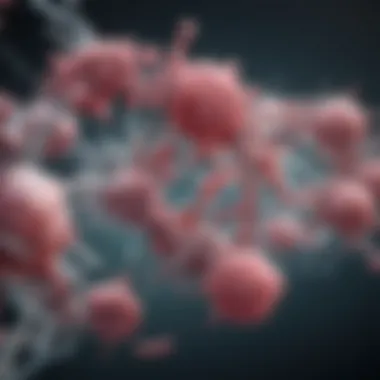An In-Depth Analysis of mRNA Vaccines and Variants


Intro
The rapid development and deployment of mRNA vaccines have represented a significant advancement in medical science. These vaccines have become a focal point in the fight against infectious diseases, particularly during the COVID-19 pandemic. Understanding how these vaccines work and their implications, especially concerning variants of viruses, is essential for students, researchers, and professionals in public health and related fields.
At the core of mRNA vaccine technology is the innovative use of messenger ribonucleic acid, or mRNA. Unlike traditional vaccines, which often use weakened or inactivated forms of viruses, mRNA vaccines utilize synthetic genetic material to instruct human cells to produce a harmless piece of the target virus. This approach triggers an immune response, equipping the body to recognize and combat the actual virus if encountered in the future.
The importance of mRNA vaccines extends beyond immediate public health responses. As variants of viruses emerge, understanding how these vaccines maintain efficacy and safety becomes crucial. This article aims to provide a comprehensive examination of mRNA vaccines, dissecting their mechanisms, development processes, and the public health implications related to variants.
Through this exploration, readers will gain valuable insights into the current landscape of mRNA technology and its future potential in the realm of medicine.
Prelims to mRNA Vaccines
The emergence of mRNA vaccines marks a significant advancement in immunology and public health. The relevance of this topic has never been more pronounced, especially given the ongoing global health challenges posed by infectious diseases. Understanding mRNA vaccines is crucial for students, researchers, educators, and professionals who are keen on the cutting edge of medical science. This section will outline the fundamentals of mRNA vaccines, addressing their definition, mechanism of action, and the historical context that paved the way for their current application.
Definition and Mechanism of Action
At its core, an mRNA vaccine is a type of vaccine that uses synthetic messenger RNA to provoke an immune response. The basic principle behind these vaccines involves the introduction of a harmless piece of the virus's genetic material into the body. Once injected, this mRNA encodes for a specific viral protein. Cells translate this instruction and produce the viral protein, which, in turn, prompts the immune system to recognize it as foreign.
The immune response that follows creates antibodies and trains T-cells to fight future infections from the actual virus. This mechanism not only prepares the immune system to respond to real infections but does so faster and more effectively than conventional vaccines. The ability to develop these vaccines rapidly is particularly vital in scenarios involving emerging variants, which can potentially alter viral protein structures.
Historical Context
The historical development of mRNA technology spans several decades, beginning with the discovery of mRNA in the early 1960s. Scientists initially focused on understanding mRNA's role in protein synthesis, laying the groundwork for its application in vaccines.
In the 1990s, researchers began to explore the possibility of using mRNA as a therapeutic tool, especially in the realm of cancer immunotherapy. Early studies identified issues with mRNA stability and delivery, spurring innovations in lipid nanoparticles.
The critical moment for mRNA vaccines came in December 2020, when the Pfizer-BioNTech and Moderna COVID-19 vaccines gained emergency use authorization. The urgency brought by the COVID-19 pandemic led to unprecedented speed in vaccine development. This event not only validated mRNA technology but also positioned it as a crucial tool for future pandemics and other therapeutic applications.
Understanding this historical context is essential as it illustrates the evolution of mRNA vaccines, which bridges fundamental scientific research to their practical application today.
Main Types of mRNA Vaccines
Understanding the main types of mRNA vaccines is crucial in recognizing their roles in modern medicine. They represent a shift towards a novel approach in immunization. mRNA vaccines utilize synthetic messenger RNA to elicit an immune response. This method allows for rapid development and adaptability which is vital during a pandemic. In this section, we will delve into two main categories of mRNA vaccines: those addressing the COVID-19 pandemic and those in development for other diseases.
COVID-19 Vaccines
Pfizer-BioNTech
The Pfizer-BioNTech vaccine, widely known as BNT162b2, is a significant advancement in the field of vaccination against COVID-19. It employs lipid nanoparticles to deliver mRNA encoding the spike protein of the SARS-CoV-2 virus. One key characteristic of the Pfizer-BioNTech vaccine is its high efficacy rate of about 95% in preventing COVID-19. This efficacy is notably beneficial during outbreaks, making it a popular choice for many countries.
A unique feature of the Pfizer-BioNTech vaccine is its storage requirement. It initially needed ultra-cold temperatures, which complicated distribution efforts. However, later studies allowed for its storage at higher temperatures for limited periods. This adaptability improves access and availability in various regions, closing gaps in the supply chain.
Moderna
The Moderna vaccine, referred to as mRNA-1273, also targets the spike protein of the SARS-CoV-2 virus. Similar to Pfizer-BioNTech, it has demonstrated an efficacy rate of approximately 94.1%. This level of effectiveness solidifies its position as a critical tool in combatting the pandemic.
One of the notable advantages of the Moderna vaccine lies in its less stringent storage requirements compared to its competitor. It can be stored at regular freezer temperatures, easing logistic challenges. However, the side effects in some participants, like myalgia and fever, indicate a response from the immune system. Understanding these reactions informs public health strategies as vaccination campaigns progress.
Vaccines in Development
Cancer Vaccines


The exploration of mRNA technology extends beyond infectious diseases into oncology, specifically for cancer vaccines. These vaccines aim to provoke an immune response against tumor-associated antigens. The key characteristic here is the potential for personalization in treatment. As each cancer has unique markers, mRNA vaccines can be tailored to target specific tumors.
A unique feature of cancer vaccines is their ability to adapt vaccines to the individual patient’s tumor profile. This tailored approach could lead to improved outcomes, but there are challenges in large-scale production and regulatory approval that need careful navigation.
Zika Virus Vaccines
Zika virus vaccines represent another promising area in the development of mRNA technology. Due to Zika's transmission by mosquitoes and its association with congenital defects, an effective vaccine is a public health priority. The main characteristic of these vaccines is their potential to incite robust immune protection against the virus.
Research indicates that mRNA vaccines for Zika can elicit both humoral and cellular immune responses, which is advantageous for developing immunity. However, as with other vaccines in development, safety and efficacy require thorough evaluation during clinical trials.
Recent advancements in mRNA technology provide hope that these efforts will soon lead to successful vaccines for various diseases, which in turn could reshape the landscape of preventive medicine.
Efficacy and Safety Profiles
Understanding the efficacy and safety profiles of mRNA vaccines is crucial in assessing their role in public health. These profiles provide insights into how well the vaccines work and any potential side effects. Without thorough examination of these factors, public trust and acceptance could be undermined. Therefore, a clear grasp of the effectiveness and the safety considerations enables healthcare professionals and policymakers to make informed decisions, ultimately guiding vaccination strategies and health recommendations.
Clinical Trial Results
Clinical trials are the backbone of vaccine evaluation. They are designed to determine vaccine efficacy before approval for public use. mRNA vaccines, such as those developed by Pfizer-BioNTech and Moderna, underwent extensive clinical trials involving tens of thousands of participants.
The primary endpoints during these trials typically include the reduction in symptomatic cases of the disease and severe outcomes such as hospitalization or death. For instance, clinical trials for the Pfizer-BioNTech vaccine demonstrated about 95% efficacy in preventing COVID-19 infection.
Trials also evaluated secondary endpoints like the percentage of participants with serious adverse reactions. Monitoring these results is vital to ensuring ongoing safety. Trials for mRNA vaccines have shown favorable efficacy rates across diverse demographics, including various age groups and individuals with comorbidities.
Additionally, long-term follow-up of trial participants continues to be an essential component of understanding persistent effects and overall durability of immune response.
Adverse Reactions and Monitoring
The efficacy of mRNA vaccines is notably paralleled by the need to monitor adverse reactions. While most reactions are mild and transient, such as injection site pain, fatigue, or headache, rare cases of severe reactions can occur. Monitoring systems like the Vaccine Adverse Event Reporting System (VAERS) in the United States help to promptly identify potential safety signals.
"In the context of vaccine safety, timely monitoring is as essential as the initial efficacy results."
Healthcare professionals recommend observing individuals for a short period post-vaccination to ensure they do not experience acute adverse reactions. Public health agencies rely on ongoing data collection to assess the long-term safety of these vaccines.
A significant component of this monitoring involves demographic variables, as reactions might differ across age, sex, or underlying health conditions. Understanding these variables assists in tailoring public health messaging regarding the mRNA vaccines.
In summary, analyzing the efficacy and safety profiles of mRNA vaccines helps shape the public dialogue surrounding vaccinations, contributing to improved health outcomes and fostering public trust in scientific advancements.
Development and Production Processes
The development and production processes of mRNA vaccines are critical to their effectiveness and availability. Understanding these processes highlights the scientific and logistical considerations necessary for bringing these vaccines to market. Efficient development and production ensure that vaccines can respond swiftly to emerging health threats, such as variants of viruses.
Synthesis of mRNA
Synthesis of mRNA is the cornerstone of mRNA vaccine creation. This process involves transcription of specific genes that encode for pathogen proteins, leading to the generation of synthetic messenger RNA. The process is approximately divided into two main stages: the in vitro transcription and purification phases.
- In Vitro Transcription: In this step, a DNA template is used to produce mRNA. This is achieved using RNA polymerase enzymes that amplify the RNA sequence corresponding to the desired antigen.
- Purification: To ensure safety and efficacy, the synthesized mRNA must be purified. Removal of contaminants such as DNA, enzymes, and residual chemicals is crucial. Purification enhances the quality of the final product, preparing it for clinical use.
The rapid synthesis capability facilitates a quick response to newly detected viral variants. The precision in the process allows for tailored vaccines for emerging pathogens.
Manufacturing Challenges


The manufacturing of mRNA vaccines poses various challenges that need to be addressed to ensure production at scale. These challenges include equipment limitations, supply chain issues, and maintaining product quality throughout the manufacturing process.
Scale-up Techniques
Scale-up techniques focus on transitioning from laboratory-scale production to large-scale manufacturing. This step is essential for ensuring that enough vaccine doses are produced to meet population needs. One key aspect of scale-up is process optimization.
- Key Characteristic: Process optimization involves enhancing reaction conditions to maximize yield and minimize costs. This characteristic is crucial when transitioning to large-scale production.
- Benefits: Efficient scale-up techniques lead to a lower cost per dose, making vaccines more accessible and improving public health outcomes.
- Unique Feature: The main benefit is the ability to maintain mRNA integrity throughout the scale-up process. The disadvantages can sometimes involve the complexity of maintaining the speed of production while ensuring safety standards, which can delay timelines.
Quality Control Measures
Quality control measures are vital in the manufacturing of mRNA vaccines. Without stringent quality standards, the efficacy and safety of the vaccines can be compromised.
- Key Characteristic: These measures often include rigorous testing at multiple stages during production to detect impurities and assess stability.
- Benefits: Implementing strict quality control leads to more reliable products, enhancing overall trust in vaccination programs.
- Unique Feature: Involving advanced analytical techniques such as chromatography provides a clear method for ensuring that the mRNA is of high quality. However, an increased focus on quality may slow down production if not managed well, posing a challenge to rapid distribution efforts.
The successful integration of scale-up techniques and quality control measures is crucial for the future of mRNA vaccines, especially as variants continue to emerge.
Factors Influencing Vaccine Distribution
The distribution of vaccines, particularly mRNA vaccines, is a complex interplay of various factors. Understanding these elements is critical for ensuring that vaccines reach all populations in a timely and efficient manner. This section will explore two primary considerations: supply chain logistics and equity in access.
Supply Chain Considerations
The efficient distribution of vaccines hinges significantly on supply chain management. This involves transport, storage, and delivery mechanisms that must be finely tuned to maintain the integrity of the vaccines. mRNA vaccines, such as those developed by Pfizer-BioNTech and Moderna, require strict temperature controls during the transportation and storage process. They need to be kept at ultra-low temperatures, which presents challenges in regions lacking proper cold chain logistics.
- Cold Chain Requirements: New technologies will facilitate better temperature monitoring and tracking.
- Distribution Channels: Partnerships with local health organizations can aid in getting vaccines to underserved areas.
- Transport Infrastructure: The existing transport network must be evaluated for capability and efficiency.
Overcoming these logistical challenges is essential for maximizing vaccine distribution. Failure to do so could lead to wastage and delays, compromising vaccination efforts.
Equity and Accessibility Issues
Equity and accessibility in vaccine distribution present moral and practical challenges. Disparities exist not only between countries but also within nations. Marginalized populations may face numerous barriers to access vaccines including socio-economic factors, geographical location, and systemic healthcare inequalities.
To address these issues, several points should be highlighted:
- Geographical Disparities: Rural and remote areas often lack healthcare facilities,
- Financial Barriers: Costs related to transportation can hinder access.
- Public Awareness and Education: Uninformed communities may be hesitant to get vaccinated, which can hinder uptake.
"Ensuring equitable access to vaccines is not just a logistical issue, but a fundamental public health responsibility."
Public Acceptance and Perception
Public acceptance and perception of mRNA vaccines are pivotal in determining their successful implementation and overall effectiveness. These perceptions are shaped by a variety of factors, including societal beliefs, individual experiences, and the dissemination of information. Understanding this aspect is crucial as it influences vaccination rates, public health policies, and the ability to combat infectious diseases effectively. When communities exhibit high levels of acceptance, herd immunity can be achieved more readily, minimizing the spread of diseases and variants.
Addressing Vaccine Hesitancy
Vaccine hesitancy remains a significant barrier to achieving optimal vaccination coverage. This reluctance can stem from concerns about safety, effectiveness, or the speed of vaccine development. Addressing these concerns requires a multi-faceted approach. First, understanding the root causes of hesitancy is essential. Surveys and focus groups can provide insights into the specific fears and misconceptions that individuals hold.
Efforts to tackle vaccine hesitancy must incorporate community engagement. Trusted figures within communities—such as healthcare professionals, local leaders, and educators—can play a critical role in bridging the gap between public health messages and individual concerns. By fostering open discussions, these influencers can help demystify the science behind mRNA vaccines and reassure the public about their safety.
Additionally, providing transparent data regarding clinical trials and real-world outcomes can alleviate fears. Success stories and testimonials from vaccinated individuals can also create a more positive narrative about mRNA vaccines.
Role of Education and Communication


Education forms the cornerstone of effective public health communication, especially regarding mRNA vaccines. The role of education in shaping perceptions is twofold: it equips individuals with knowledge about how vaccines function, and it allows them to make informed decisions about their health.
Effective communication strategies also incorporate social media and traditional platforms to reach diverse audiences. Information should be clear, concise, and culturally relevant to engage different demographic groups. For example, visuals like infographics or videos can be particularly effective in explaining complex scientific concepts simply.
Moreover, proactive communication is vital during crises. Misinformation can spread rapidly, so it's essential that public health authorities address inaccuracies with factual data in real time. Providing ongoing education about emerging variants and their implications for vaccination can also maintain public awareness and trust.
Effective communication leads to informed decisions, enhancing vaccine uptake and community health.
In summary, public acceptance is significantly influenced by addressing vaccine hesitancy through community engagement and effective educational strategies. By fostering open dialogue and providing clear information, health authorities can help enhance trust, ultimately leading to a healthier society.
Future Perspectives of mRNA Technology
The evolution of mRNA technology signifies a paradigm shift in the field of medicine. The potential of mRNA extends beyond just infectious diseases. Future applications of this technology could redefine therapeutic strategies across multiple medical disciplines. This section explores two primary avenues that mRNA technology is poised to expand into: therapeutics for autoimmune diseases and personalized medicine applications.
Expansion Beyond Infectious Diseases
Therapeutics for Autoimmune Diseases
The development of therapeutics for autoimmune diseases using mRNA technology represents a significant step forward in treatment modalities. Traditional therapies for autoimmune conditions often involve broad immunosuppression, which can lead to adverse effects and increased susceptibility to infections. In contrast, mRNA-based treatments aim to deliver specific proteins that can modulate the immune response without compromising the overall immune system.
One key characteristic of these therapeutics is their ability to target the root cause of the autoimmune response. This specificity can potentially reduce side effects and improve patient outcomes significantly. By designing mRNA to encode antigens relevant to the autoimmune disorder, therapies can train the immune system to tolerate these antigens instead of attacking them.
However, there are challenges associated with mRNA therapeutics in this space. Their delivery mechanisms must be efficient to ensure the mRNA reaches the appropriate cells. Moreover, longer-term effects and immune reactions to the mRNA itself are still under investigation. Balancing therapeutic effects while maintaining safety is crucial for this innovative approach.
Personalized Medicine Applications
Personalized medicine leverages individual genetic information to tailor treatments for specific patients. mRNA technologies enhance this approach by allowing for rapid customization of therapies based on genetic profiles. For instance, profiling tumor mutations can lead to the development of personalized cancer vaccines designed to elicit an immune response specifically against a patient's tumor cells.
The key characteristic of personalized medicine applications is the capability to respond dynamically to patient needs. These applications offer a unique feature of adaptability, where treatments can be adjusted as more is learned about the patient’s condition. Such flexibility is not possible with more traditional approaches that produce one-size-fits-all solutions.
Yet, challenges persist. The logistics of producing personalized mRNA treatments on a large scale, along with ensuring regulatory compliance, make this path complex. Nevertheless, the advantages of potentially more effective and less toxic therapies make it a promising avenue to explore.
Research Directions and Innovations
The growth of mRNA technology has spurred numerous research endeavors aiming to harness its full potential. Innovations are ongoing in delivery systems, stability enhancements, and incorporation of novel adjuvants to boost efficacy. With global research collaborations increasing, the prospects for mRNA technology are more promising than ever.
"Understanding and leveraging the capabilities of mRNA may open untapped domains of medical research, yielding techniques that challenge longstanding paradigms."
In summary, the future perspectives of mRNA technology include exciting developments in treatment for autoimmune diseases and personalized medicine applications, paving the way for more targeted and efficient therapies. As research continues and innovations emerge, the applications of mRNA technology promise to expand greatly, marking a new era in medical treatment.
Finale
The conclusion encapsulates the relevance of mRNA vaccines in contemporary medicine and public health. These vaccines have shown immense potential in combating infectious diseases, particularly highlighted during the COVID-19 pandemic. Their adaptability, leveraging genetic material to instruct cells to produce proteins akin to pathogens, has transformed vaccine development. With ongoing advancements, mRNA technology may further expand into other domains like cancer treatment and personalized medicine.
Summary of Findings
Throughout this article, various aspects of mRNA vaccines were analyzed. Key findings include:
- Mechanisms of Action: mRNA vaccines operate through a straightforward mechanism, utilizing messenger RNA to induce an immune response against specific pathogens. This approach has shown to promise higher efficacy rates compared to traditional vaccines.
- Types of Vaccines: The two prominent categories, namely the Pfizer-BioNTech and Moderna vaccines, have been extensively studied and demonstrated significant protection against COVID-19.
- Safety Profiles: Clinical trials indicate a generally favorable safety profile, although vigilance is necessary to monitor potential adverse reactions post-vaccination.
- Challenges in Distribution: Factors affecting distribution, such as supply chain dynamics and accessibility issues, must be addressed to ensure equitable vaccine rollout worldwide.
- Public Perception: Understanding public acceptance is imperative for achieving herd immunity; addressing concerns and promoting accurate information can mitigate hesitancy.
Call for Continued Research
Continued research in mRNA technology is crucial. The landscape of infectious diseases is continually evolving, and new variants may arise, necessitating adaptations in vaccination strategies. Moreover, exploring mRNA applications beyond infectious diseases can play a notable role in future medical interventions.
Future research should focus on:
- Monitoring Variants: Ongoing genomic surveillance to track changes in virus variants is essential for developing updated vaccines that remain effective.
- Innovative Therapeutics: Investigating the use of mRNA for therapies targeting chronic conditions and autoimmune diseases could broaden its scope significantly.
- Public Policies: Evaluating and refining public health strategies to enhance vaccination coverage and combat misinformation are necessary steps.
In summary, mRNA vaccines represent a significant advancement in medical science. Sustaining momentum through research and innovation will be vital for harnessing their full potential in addressing current and future health challenges.







